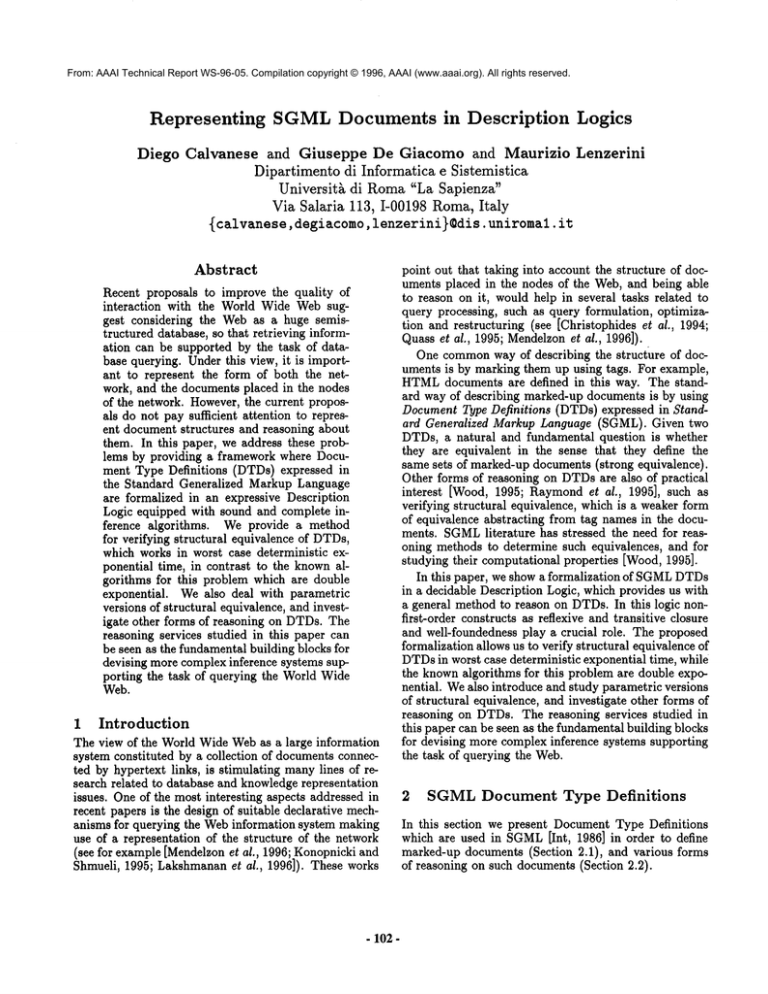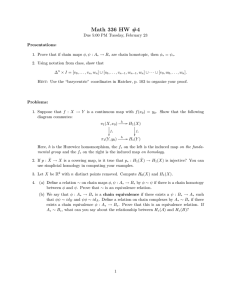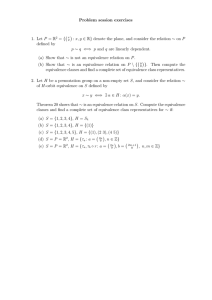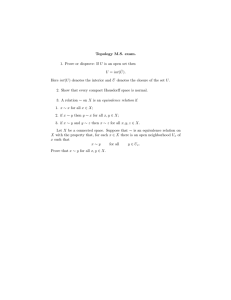
From: AAAI Technical Report WS-96-05. Compilation copyright © 1996, AAAI (www.aaai.org). All rights reserved.
Representing
Diego Calvanese
SGMLDocuments in Description
Logics
and Giuseppe De Giacomo and Maurizio Lenzerini
Dipartimentodi Informatica e Sistemistica
Universitg di Roma"La Sapienza"
Via Salaria 113, 1-00198 Roma,Italy
{calvanese, degiacomo, lenzerini)~dis, uniromal, it
Abstract
Recent proposals to improve the quality of
interaction
with the World Wide Web suggest considering the Webas a huge semistructured database, so that retrieving information can be supported by the task of database querying. Under this view, it is important to represent the form of both the network, and the documents placed in the nodes
of the network. However, the current proposals do not pay sufficient attention to represent document structures and reasoning about
them. In this paper, we address these problems by providing a framework where Document Type Definitions (DTDs) expressed
the Standard Generalized Markup Language
are formalized in an expressive Description
Logic equipped with sound and complete inference algorithms. We provide a method
for verifying structural equivalence of DTDs,
which works in worst case deterministic exponential time, in contrast to the knownalgorithms for this problem which are double
exponential. Wealso deal with parametric
versions of structural equivalence, and investigate other forms of reasoning on DTDs.The
reasoning services studied in this paper can
be seen as the fundamental building blocks for
devising more complex inference systems supporting the task of querying the World Wide
Web.
1
Introduction
The view of the World Wide Webas a large information
system constituted by a collection of documents connected by hypertext links, is stimulating manylines of research related to database and knowledgerepresentation
issues. One of the most interesting aspects addressed in
recent papers is the design of suitable declarative mechanisms for querying the Webinformation system making
use of a representation of the structure of the network
(see for example[Mendelzonet al., 1996; Konopnickiand
Shmueli, 1995; Lakshmananet al., 1996]). These works
- 102-
point out that taking into account the structure of documents placed in the nodes of the Web, and being able
to reason on it, would help in several tasks related to
query processing, such as query formulation, optimization and restructuring (see [Christophides et al., 1994;
Quass et al., 1995; Mendelzonet al., 1996]).
One commonway of describing the structure of documents is by marking them up using tags. For example,
HTMLdocuments are defined in this way. The standard way of describing marked-up documents is by using
Document Type Definitions (DTDs) expressed in Standard Generalized Markup Language (SGML). Given two
DTDs, a natural and fundamental question is whether
they are equivalent in the sense that they define the
same sets of marked-up documents (strong equivalence).
Other forms of reasoning on DTDsare also of practical
interest [Wood, 1995; Raymondet al., 1995], such as
verifying structural equivalence, which is a weaker form
of equivalence abstracting from tag names in the documents. SGMLliterature has stressed the need for reasoning methods to determine such equivalences, and for
studying their computational properties [Wood, 1995].
In this paper, we show a formalization of SGMLDTDs
in a decidable Description Logic, which provides us with
a general method to reason on DTDs.In this logic nonfirst-order constructs as reflexive and transitive closure
and well-foundedness play a crucial role. The proposed
formalization allows us to verify structural equivalence of
DTDsin worst case deterministic exponential time, while
the knownalgorithms for this problem are double exponential. Wealso introduce and study parametric versions
of structural equivalence, and investigate other forms of
reasoning on DTDs. The reasoning services studied in
this paper can be seen as the fundamental building blocks
for devising more complex inference systems supporting
the task of querying the Web.
2
SGMLDocument Type Definitions
In this section we present Document Type Definitions
which are used in SGMLlint, 1986] in order to define
marked-up documents (Section 2.1), and various forms
of reasoning on such documents (Section 2.2).
E appears on the left hand side. Wealso assume that
2.1
DTDs and Documents
for each element E appearing in P, there is an element
An SGMLdocument consists of an SGMLprologue and
type definition E --+ ~ in which E is the symbol on the
a marked-up document instance. The prologue includes
left hand side. In fact, if such condition is not satisfied,
a DocumentType Definition (DTD), which is constituted
the grammar can easily be transformed in polynomial
by a set of element type definitions defining the generic
time into one that generates the same set of marked-up
structure of the various components of the marked-up
documents, and in which the condition holds.
document instance. The logical components of a docuThe set does(P, S) of marked-up documents generated
ment are called elements.
by P starting from a symbol S is inductively defined as
It is well knownthat the fundamental characteristics
follows:
of DTDscan be formalized by means of Extended Context Free Grammars (ECFGs) [Wood, 1995]. Marked-up
¯ If S is a terminal, then does(P, S) =
document instances are seen as syntax trees constructed
¯ If S is an element and (S --+ a) E P, then
according to the grammar, where the tree structure is
determined by the various tags that occur in the docdocs(P, S) = {<S> dl " .d~ </S> I
ument and that constitute
the markup. An ECFGis a
3~ 6 a such that ~ = $1 ...Sk and
tuple (E, T, P, I), where E is an alphabet of nonterminal
di E docs(P, Si), for i E {1,...,k}}
symbols, T is an alphabet of terminal symbols, P is a set
The set of marked-up documents generated by a DTD
of production rules, and I E E is the initial symbol of
7) = (E, T, P, I) is given does(P, I).
the grammar. The nonterminal symbols are the elements
defined in the DTD,and the start symbol is the element
2.2
Equivalences
and Inclusions
between
that specifies the document type. The terminal symbols
DTDs
are the basictypesof SGML,suchas #PCDATA,which
represent
generic
(unmarked)
strings
withno associated Given two DTDs,a fundamental problem is to determine
structure
within
theDTD.In thefollowing,
withtheterm whether they are equivalent in some sense~ i.e. whether
symbol,
denoted
by theletter
S, we meana generic
ter- they define the same sets of documents [Wood, 1995;
minalor nonterminal
symbolin E U T. Eachproduction Raymondet al., 1995]. Here, we consider a more general
ruleE -~ a of theECFGcorresponds
to an element
type problem, which is that of checking various forms of landefinition.
E isthedefined
element,
anda, called
content guage inclusion (instead of equivalence). The most basic
model,
is an expression
overthesymbols
of thegrammar form of inclusion (equivalence) is inclusion (equality)
constructed
according
to thefollowing
syntax:
the sets of marked-up documents generated by the two
DTSs. In general,
when comparing DTDs we assume
I I I
without loss of generality that they are over the same
In fact, a is a regular expression with "," denoting conalphabets of terminals and elements.
catenation and ’1" denoting union. Additionally, in conFormally,
let :Pl = (E,T, PI,I1) and :P~
tent models, the following standard abbreviations are
(E, T, P2,/2) be two DTDs.Wesay that 7)1 str ongly
used:
included in T)2, denoted with ~1 -<_, ~2, if does(P1, I1)
does(P2, I2).
For determining strong inclusion, the names of the
start
and end tags that constitute the markup of the two
O~"b : O~, Ol*.
documents play a fundamental role.
Whenno ambiguity may arise, we identify a with the
In some cases, however, the actual names of the tags
set of words generated by the regular expression that a
may not be relevant while the document structure imrepresents.
posed by the tags is of importance. The form of inclusion
obtained by ignoring the names of tags and considering
Figure 1 shows an example of a DTD M for a
only their positions is called structural inclusion [Wood,
simple mail document, expressed in SGMLsyntax. It
1995]. One DTDsis structurally included into another
is straightforward to derive the set of ECFGproductions
if, when we replace in every document generated by the
corresponding to the various element type definitions.
DTDscontain in fact also other aspects that are not
DTDsall start and end tags with the unnamed tags <>
directly related to the document structure. An example
and </> respectively, the resulting sets for the two DTDs
is the possibility to associate to each element a set of
are one included into the other.
While the restrictions
imposed by strong inclusion
properties by means of a so called attribute list. In the
may be too strict in some cases, structural inclusion,
following, for the sake of simplicity, we do not consider
which ignores completely all tag names, may be too
those additional aspects. Weremark, however, that the
weak. A natural generalization of these two concepts
representation of DTDsin terms of Description Logics
provided in Section 3, makes it straightforward to take
is obtained by considering a spectrum of possible inclualso these aspects into consideration.
sions, of which strong and structural inclusion are just
the two extremes. The different forms of inclusion are
Let :P = (E, T, P, I) be a DTD.Weassume without
loss of generality that for each element E E E, P conobtained by considering certain tag names as equal, and
others as different, when confronting documents. This
tains at most one element type definition E --+ c~ where
- 103-
<!DOCTYPE
Hail [
<!ELEMENT
Hail
<!ELEMENT
From
<!ELEMENT
To
<!ELEMENT
Subject
<!ELEMENTBody
<!ELEMENTAddress
(From, To, Subject,Body)>
(Address)>
(Address)+>
(#PCDATA)>
(#PCDATA)>
(#PCDATA)>
Figure h DTDM for mail documents
allows us to parameterize inclusion (and therefore equivalence) of DTDswith respect to an equivalence relation
on the set of tag names.
Formally, we consider an equivalence relation iR on
the set E of nonterminal symbols. For an element E E
E, we denote by [E]n the equivalence class of E with
respect to T~. Given a DTD7) = (E, T, P, I) and such
an equivalence relation iR, we inductively define the set
docsTe(P, S) of T~.marked-up documents generated by P
starting from a symbol S as follows:
¯ If S is a terminal, then doesn(P, S) =
* If S is an element and (S --+ a) E P, then
docsn(P , S)
di dk
I
3~ E a such that ~ = Si ... Sk and
d, ¯ docs~(P, Si), for i ¯ {1,...,k}}
The set of 7~-marked-up documents generated by a DTD
i/) = (E, T, P, I) is given docsn(P, I).
For two DTDs 7)1 = (E,T, Pi,Ii)
and /)2
(E, T, P2,/2) and an equivalence relation 7~ on E, we say
that 7)1 is R.included in 7)2, denoted with 7)1 ___n7)2,
docs~(P i , Ii ) C docsn(P 2, Is).
Observe that, if we choose for 7~ the equivalence relation in which all equivalence classes are singletons, we
obtain strong inclusion. On the other hand, if ~ contains
a single equivalence class constituted by the whole set E,
we obtain structural inclusion.
Representing
on them
3
DTDs and Reasoning
Q, and arbitrary roles by R, all possibly with subscripts.
The semantics of the constructs above is the standard
one, except for the construct wf(R), called well-founded,
which is interpreted as those objects that are the initial
point of only finite R-chains. Formally
(w/(R)) ~ = {o0 ¯ AZI COl, 02,... (ad infinitum)
3oi:(o. oi+) Rz}.
A 7)f~ knowledgebase is a set of assertions of the form
Ci E C2,
where Ci and C2 are arbitrary concepts without any restrictions. Weuse also Ci -- C2 as an abbreviation for
the pair of assertions Ci E C2 and C2 E C1.
An interpretation 2: satisfies the assertion Ci E C2
if Ciz C_ C~. An interpretation
is a model of a knowledge base IC if it satisfies all assertions in ]Ci. Typical
reasoning services (i.e. subsumption,satisfiability, logical
implication) in 7)/: are EXPTIME-complete[Calvanese
et al., 1995; Calvanese, 1996].
Let D = {7)i,... ,7)k} be a finite collection of DTDs.
Weassume without loss of generality that all DTDsin
the collection share the same alphabets T of terminals
and E of elements, i.e. that 7)~ = (E,T, Pi,h), for
{1,...,
k}. Wedescribe now how to construct from D
a 7)£ knowledge base ]C capable of fully capturing the
various structural aspects of the DTDsin D.
Independently from the particular collection of DTDs,
]C contains special assertions that model general structural properties of marked-up documents. Specifically,
]C contains the following assertions:
DStruc
Let us introduce the logic 7)£ which we use for formalizing DTDsand which is a simplified version of the
formalism in [Calvanese et al., 1995]. The syntax of 7)£
is as follows:
c AITI-LICIC, nC2IGlUC21
VR.C
l 3R.C
l 3<-"Q.C
l 3<-"Q-.C
l
(Q1c_Q2)I(Qi-c_I w/(R)
Q
R
~ P IQiuQ2 I QinQ2 I Qi\Q2
~ Q IRIU R2IR1
o R2IR- I R* lid(C)
where we denote concept names by A, arbitrary concepts
by C, role names by P, basic roles (i.e. roles obtained
by union, intersection and difference of role names) by
---- V(f Ur).DStruc
3<if.T R 3-<ir.T R 3-<i(f U r)-.T
wf(f U r)
Tag _E DStruc~V(f Ur)./
Terminal _E DStrucN V(f U r).iR-~Tag
The concept DStrucintroduces two distinguished roles f
and r (standing for "first" and "rest" respectively) which
are used to represent the tree-like form of marked-up
documents by exploiting the standard encoding of n-ary
trees as binary trees. The assertion on DStruc imposes
functionality of f and r and the existence of at most one
predecessor, hence enforcing a binary tree structure on
tThls means that we adopt descriptive
cydes.
- 104-
semantics for
MailM
DStrucR3f.StartMailR3(roid(3f.FromM)
o roid(3f.TOM)o
oid(3f.SubjeCtM)
oroid(3f.BodYM)
or).EndMail
FromM
DStrucM3f.StartFrom~3(ro
id(3f.AddressM)
r).EndFrom
TOM
DStrueN3f.StartTo
R 3(ro id(3f.AddressM)
o ro(id(3f.AddressM)or)*).EndTo
DStrucM3f.StartSubjectM3(ro
id(3f.#PCDATA)
or).EndSubject
Subject
M
DS~rucR3f.StartBodyR3(ro
id(3f.#PCDAT~o
r).EndBody
Body
M
AddreSsM
DStrucn 3f.StartAddress
N 3(roid(3f.#PCDATA)
o r).EndAddress
#PCDATA E Terminal
Figure 2: Knowledge base derived from the DTDM
the (f O r)*-connected componentsof models of the knowledge base. Observe that the use of the well-foundedness
construct is essential to impose finiteness and acyclicity
of such connected components.
The symbols that appear in the DTDsand the element
type definitions are then encoded in ]E as follows:
¯ For each terminal F E T, ]E contains an assertion
each element E we have introduced two concept names
StartE, EndE representing its tags, and one concept
name Ev~ for each DTD7)i containing a definition of
E.
Westress that for each Ez~ the well-foundedness construct in the assertion on DStruc ensures the following: Given a model A~f of ]E, it is possible to determine
whether an object o is an instance of E~ by taking into
F E Terminal.
account only the structure of the (f U r)* connected com¯ Foreachelement
E E E, ]E contains
twoassertions ponent of A4 containing o, and the concepts representing
tags and terminals on such component. This property is
StarvE _ Tag
essential in order to obtain the desired correspondence
between reasoning on the DTDsin D and reasoning on
EndE E_ Tag,
]E.
whereStartEand EndE represent
startand end
Figure 2 shows the knowledge base corresponding to
tags.
the DTDM described in Figure 1. We have omitted
¯ For each 7)i E D, and for each element E, such that
the assertions that are independent from the particular
(E -~ ~) E pi2, ]E contains the assertion:
DTD,introduced above, as well as those for the concepts
E~ - DStrucM 3f.StartE17 3(r o r(o~)).EndE that represent the various start and end tags.
The knowledgebase ]E can directly be used to determwithr(a)defined
inductively
as:
ine strong inclusion between DTDs.
Theorem 1 Let 7)i and 7)j be two DTDs in D, and
r(¢) = id(T)
]E the 7)£ knowledge base derived from D as specified
r(S) - id(3f.cn(7)i,S))or
above. Then 7)i is strongly included in 7)j if and only
cn(7)i, Ii) is subsumedby cn(7)j, b)
o
=
The knowledge base ]E can also be extended in order
=
to verify the other forms of inclusions introduced in Sec,,
m
tion 2. LetR = {{E~,..., E,~},...,{E
1
be
where cn(., .) is a mappingthat associates to each
t ,...,En,,,}}
an equivalence relation on the set E of elements. Weobpair constituted by a DTD7)i and a symbol S
tain the knowledge base ]E~ from ]E by adding for each
concept name as follows:
equivalence class {E~,..., E~) and for each element E~,
fEz~,
ifS=EforanelementEEE
cn(7) S)
with i E {1,..., nj-1}, the assertions:
1.F
if S = F for a terminal F E T
The role r(a) reflects the structure imposed by a
the parts of a document that are defined by E --> a.
It can be explained in terms of an encoding of the tree
representing the marked-up documentinto a binary tree.
Observe that while for each tag in the collection of
DTDs we have a unique concept name, the information about the DTDa given element belongs to is explicitly carried out in the knowledgebase. Indeed, for
2Weassumewithout loss of generality that every dement
¯ appearing in Pi, appears also as the left hand side of some
element type definition in Pi.
- 105-
StartE{
_- Star~;E{+
1
EndE~ -1 EndEd+
With these assertions we are essentially imposing the
equivalence of all the concepts representing tags of elements belonging to each set {E~,...,E~}. Therefore,
when reasoning on ]Ere the differences between the various tags associated to equivalent elements are ignored,
coherently with the notion of g-inclusion.
Theorem 2 Let 7)i and 7)~ be two DTDs in D, T~
equivalence relation on E, and ]Ere the 7)£ knowledge
base derived from D as specified above. Then ~Di is T¢included in Dj if and only if cn(~i, h) is subsumed
cn(V, b)
Fromdecidability in deterministic exponential time of
logical implication in ~D£[Calvanese et al., 1995] we obtain as an immediate consequence an EXPTIMEupper bound for 7~-inclusion and T~-equivalence between
DTDs.
Corollary 3 7~.inclusion and 7~.equivalence between
two DTDscan be verified in deterministic exponential
time in the size of the DTDs.
As mentioned, the previously knownalgorithms for structural equivalence were doubly exponential, while by the
theorem above we obtain a single exponential upper
bound.
4
Conclusions
Several recent papers dealing with the problem of querying the World Wide Webargue that the current techniques for representing and reasoning on documentstructures should be improved. Wehave provided a view of
DTDsas concepts of the expressive Description Logic
~P£, and we have demonstrated that this approach is indeed very effective for both faithfully representing document structures, and answering several open questions
regarding DTDequivalence checking. By exploiting the
constructs of ~P£, we are able to integrate into the structure of documents also aspects related to the semantics
of the information contained in them. For example, the
so called attribute lists of DTDelements can be modeled
easily in ~D/~. As another example, if part of a document
(corresponding to a terminal symbol T in the DTD)includes a table with information about, say, departments
and employees, this can be represented by adding suitable properties to the concept corresponding to T. We
can also represent links to other documents,such as those
typically found in the Web,by means of a special concept
with suitable roles for the nameof the link and the associated anchor. Obviously, by means of suitable assertions
we can constrain the anchor to point to a document of a
specific DTD.
Weare extending our work along two directions. On
one hand, we aim at capturing more aspects of DTDs
in order to represent, for example, other properties of
documents (attribute list in the terminology of SGML),
exceptions (as described in [Wood,1995]), or constraints
on the number of occurrences of a certain pattern in an
element definition.
On the other hand, the deductive
power of ~D/; allows us to study new types of reasoning
on DTDs,such as further forms of parameterized equivalence (e.g. abstracting from the definition of a specified
element), or document classification (infer which is the
DTDthat best matches a given marked document among
a set of candidates).
References
[Calvanese et al., 1995] Diego Calvanese,
De Giacomo, and Maurizio Lenzerini.
Giuseppe
Structured
- 106-
objects: Modeling and reasoning. In Proc. of the Jth
Int. Conf. on Deductive and Object-Oriented Databases (DOOD-95), number 1013 in Lecture Notes in
Computer Science, pages 229-246. Springer-Verlag,
1995.
[Calvanese, 1996] Diego Calvanese. Finite model reasoning in description logics. In Luigia C. Aiello, John
Doyle, and Stuart C. Shapiro, editors, Proc. of the 5th
Int. Conf. on the Principles of KnowledgeRepresentation and Reasoning (KR-96). Morgan Kaufmann, Los
Altos, 1996.
[Christophides et al., 1994] V. Christophides, S. Abiteboul, S. Cluet, and M. Scholl. From structured documents to novel query facilities.
In R. T. Snodgrass
and M. Winslett, editors, Proc. of the ACMSIGMOD
Int. Conf. on Management of Data, pages 313-324,
Minneapolis (Minnesota, USA), 1994.
lint, 1986] International Organization for Standardization. IS0-8879: Information processing - Text and
office systems - Standard Generalized Markup Language (SGML), October 1986.
[Konopnicki and Shmueli, 1995] D. Konopnicki and
O. Shmueli. W3QS: A query system for the World
Wide Web. In Proc. of the 21th Int. Conf. on Very
Large Data Bases (VLDB-95), pages 54-65, 1995.
[Lakshmanan et al., 1996] L. Lakshmanan, F. Sadri,
and I. N. Subramanian. A declarative language for
querying and restructuring the Web. In Proc. of the
6th Int. Workshop on Reaseareh Issues in Data Enginnering: Interoperability of Nontraditional Database
Systems. IEEE Computer Science Press, 1996.
[Mendelzon et al., 1996] A. Mendelzon, G. A. Mihaila,
and T. Milo. Querying the World Wide Web.
ftp ://db.toronto,
edu/pub/papers/websql,
ps,
1996.
[Quass et al., 1995] D. Quass, A. Rajaraman, I. Sagiv,
J. Ullman, and J. Widom. Querying semistructured
heterogeneous information. In Proc. of the ~th Int.
Conf. on Deductive and Object-Oriented Databases
(DOOD-95},pages 319-344. Springer-Verlag, 1995.
[Raymond et al., 1995] D. R. Raymond, F.W. Tompa,
and D. Wood. From data implementation
to data
model: Meta-semantic issues in the evolution of
SGML.Computer Standards and Interfaces, 1995.
[Wood, 1995] Derick Wood.
Standard Generalized
Markup Language: Mathematical and philosophical issues. In Jan van Leeuwen, editor, Computer Science
Today, Recent Trends and Developments, number 1000
in Lecture Notes in ComputerScience, pages 344-365.
Springer-Verlag, 1995.


![MA1124 Assignment3 [due Monday 2 February, 2015]](http://s2.studylib.net/store/data/010730345_1-77978f6f6a108f3caa941354ea8099bb-300x300.png)






